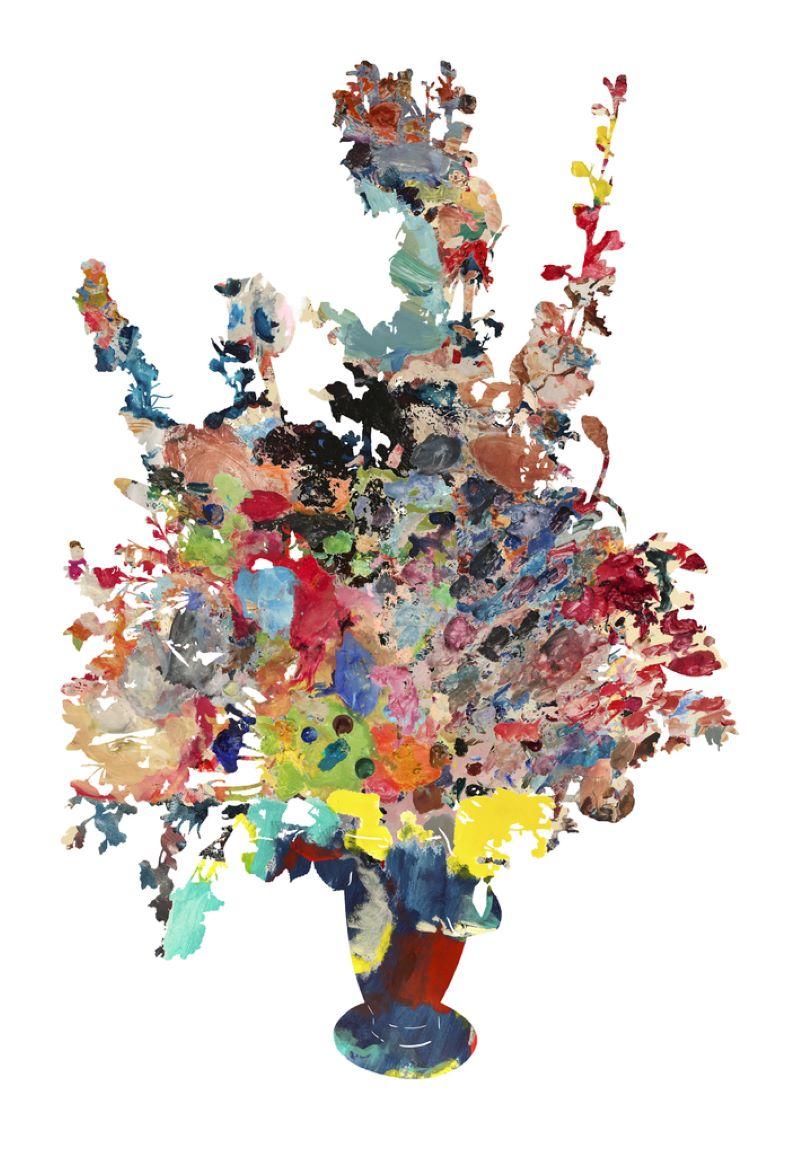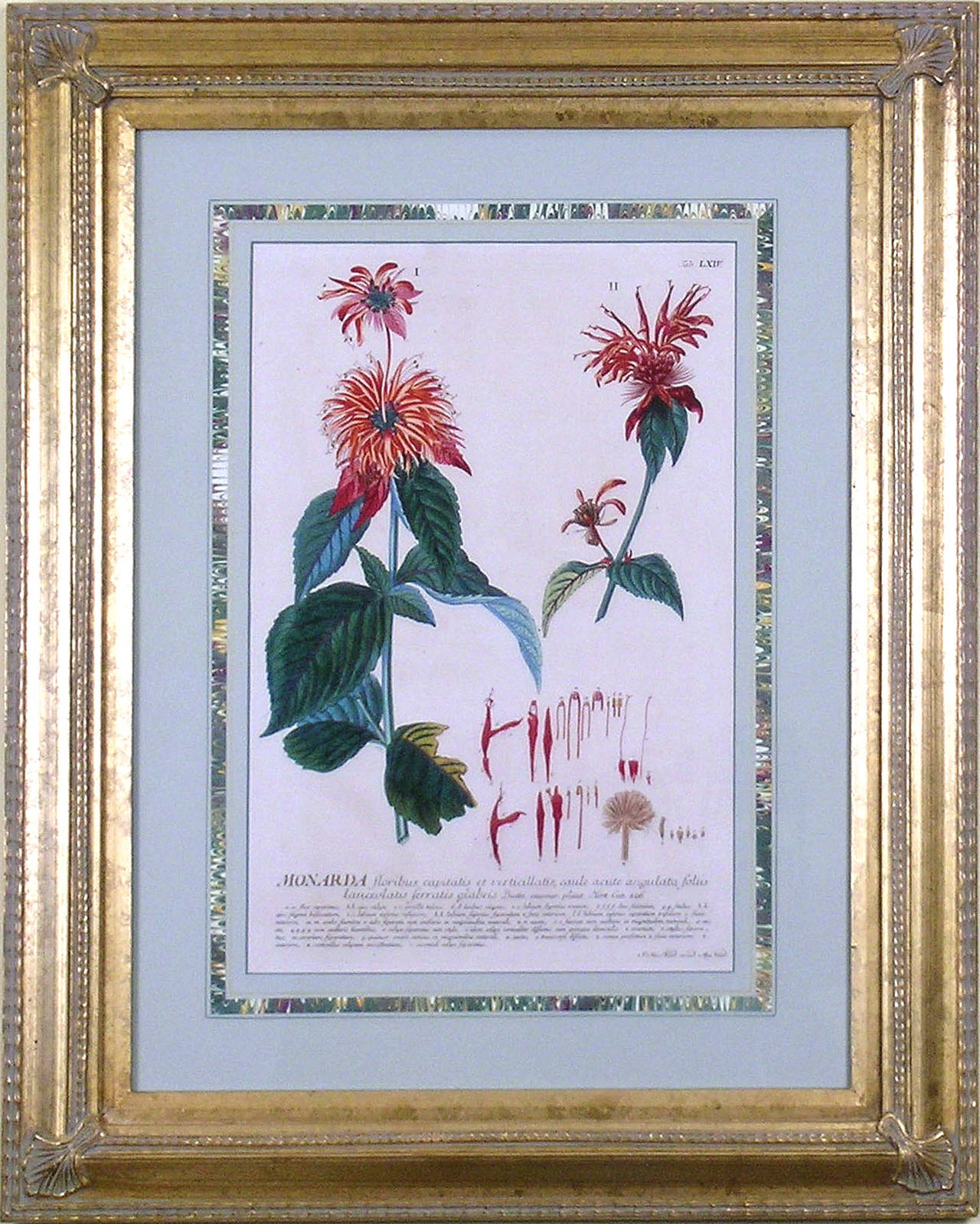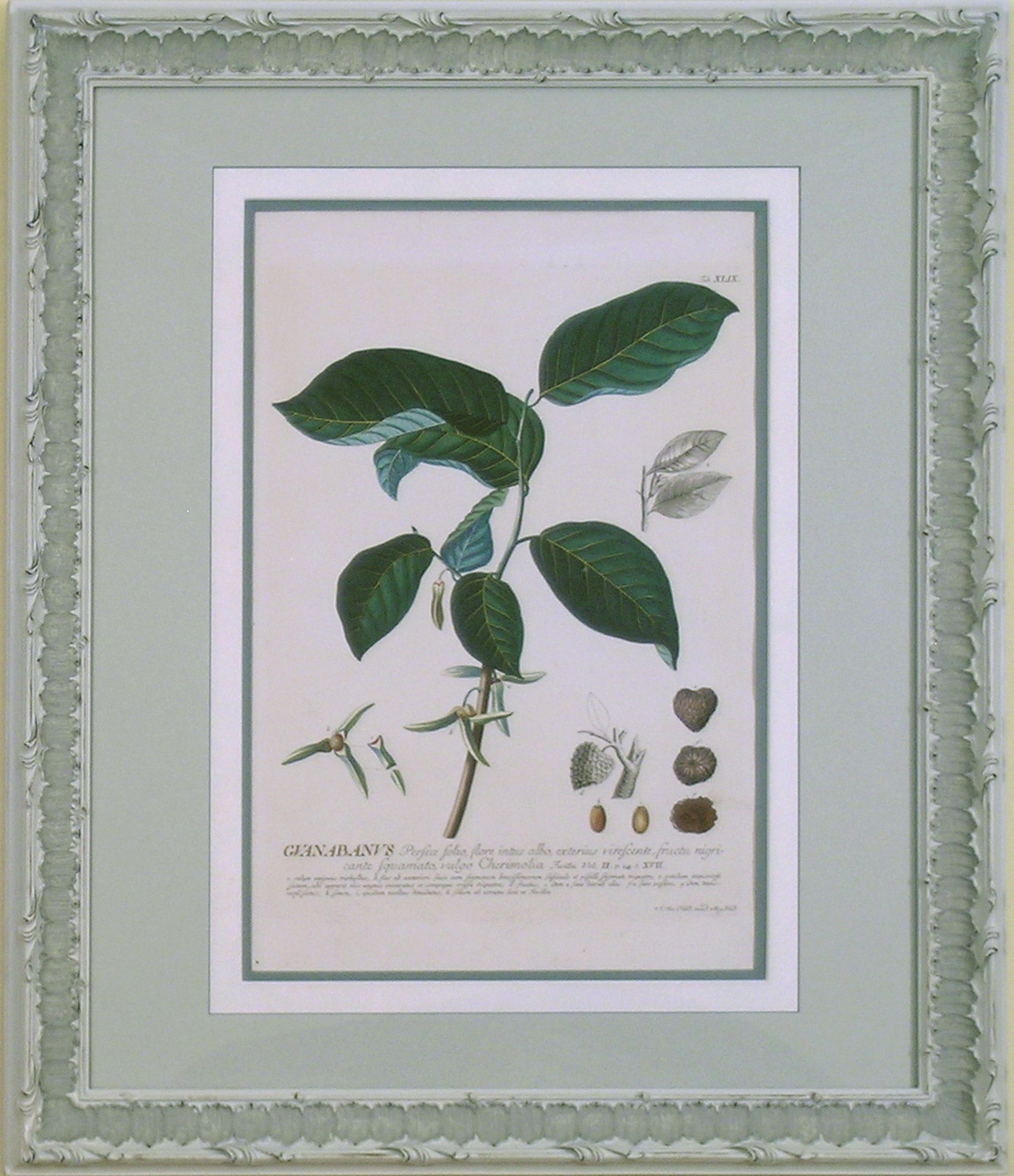Items Similar to N. 66 Aloe Tuberosa Levis
Want more images or videos?
Request additional images or videos from the seller
Johann Wilhelm WeinmannN. 66 Aloe Tuberosa Levis1735-1747
1735-1747
About the Item
JOHANN WILHELM WEINMANN.
Phytanthoza Iconographia….
Published by Raisbonae.
Regensburg, 1735-47.
Engraved by J.J. Haid, J.E. Ridinger, B. Seuter and G.D. Ehret.
Hand-colored mezzotint engravings.
10.25” to 10.75” x 15.5 to 18.25”
14k Gold Leaf Frame
1025 plates.
At $13.00 per volume, the four volumes of Weinmann’s Phytanthoza Iconographia, from the library of Don Antonio, may have seemed a bit expensive in 1824. However, the directors of the Library Company considered the materia medica, the most extensive compendium to that time, worth the money and acquired it for the Loganian Library. We applaud their wisdom.
Compiled under the supervision of Weinmann, a Ratisbon apothecary, this interesting and valuable 18th century florilegium contains 1,025 plates of plants, trees, fruits and vegetables. Various artists were employed in the production, including the distinguished German botanical draughtsman Georg Dionysius Ehret. The text in Latin and German was the work of Johann Georg Dieterichs, his son Ludwig Michael Dieterichs and Ambrose Karl Bieler.
The Phytanthoza Iconographia is remarkable not only for the beauty and accuracy of its illustrations, but also for its successful use of color printing. It is considered the premier work in mezzotint engravings. Most of the plates have solid areas in colored mezzotint; the watercolor details were added later by hand. The frontice piece and two portraits, printed in blue, are the work of the Augsburg mezzotinter Johann Jakob Haid who with his fellow citizens, Ridinger and Seuter did the engravings of the plants.
References: Great Flower Books: 1700 – 1900. Sitwell. Atlantic Monthly Press. NY, 1990.
The Art of the Plant World. Rix. Overlook Press. NY, 1982.
- Creator:Johann Wilhelm Weinmann (1683 - 1741, German)
- Creation Year:1735-1747
- Dimensions:Height: 26 in (66.04 cm)Width: 21.25 in (53.98 cm)Depth: 2 in (5.08 cm)
- Medium:
- Movement & Style:
- Period:
- Condition:Wonderful example of 18th Century fascination with botany. Of note is the ornate pot chosen for this rare (to Europe) species. Clean paper. Full margins. Sharp, crisp image. Strong original hand-coloring.
- Gallery Location:Florham Park, NJ
- Reference Number:
Johann Wilhelm Weinmann
Johann Wilhelm Weinmann (1683-1741) was a botanist, pharmacist and academic scholar who directed a famous pharmacy in Regensburg. The "Phytanthoza Iconographia" was his masterpiece; a huge work in eight folio volumes, which provided one of the most comprehensive botanical references of the eighteenth century. It has been described as a "pioneering work of botanical prints” and it remains today one of the most ambitious works ever undertaken, displaying over 4,000 species. The artist for much of the work was the gifted and very collectible Georg Dionysius Ehret (1708-1770). Born into a humble family in Heidelberg, Germany, Ehret was taught to draw by his father at an early age. As a young man, he worked as a gardener, first for the Elector of Heidelberg and then the Margrave of Badaen-Durlac. He became a well respected botanist and entomologist and one of the most influential European botanical artists of all time.
About the Seller
5.0
Vetted Seller
These experienced sellers undergo a comprehensive evaluation by our team of in-house experts.
1stDibs seller since 2014
161 sales on 1stDibs
Typical response time: 2 hours
- ShippingRetrieving quote...Ships From: Florham Park, NJ
- Return PolicyA return for this item may be initiated within 1 day of delivery.
More From This SellerView All
- Monarda (aka Bee Balm, Bergamot)By Georg Dionysius EhretLocated in Florham Park, NJGEORGE DIONSYSIUS EHRET (1708-1770). Plantae Selectae.... Text by Dr. Christoph Trew. Drawn by Georg Dionsysius Ehret. Engraved by Johannes Jacobus and Johannes Elias Haid. Nure...Category
18th Century and Earlier Academic Prints and Multiples
MaterialsGold Leaf
- Guanabanus (Guabana or Soursop Fruit)By Georg Dionysius EhretLocated in Florham Park, NJGEORGE DIONSYSIUS EHRET (1708-1770). Plantae Selectae.... Text by Dr. Christoph Trew. Drawn by Georg Dionsysius Ehret. Engraved by Johannes Jacobus and Johannes Elias Haid. Nuremberg, 1750-73. Hand-colored engravings. Titles highlighted with goldleaf. 100 plates. 19.5” x 13.5” Unframed. A supplement of 20 plates issued by B.C. Vogel in 1790. "The dominant influence in botanical art during the middle years of the 18th century." "One of the finest records of cultivated flowers..." "His accuracy and general excellence as a true botanical artist have never been equaled." Ehret’s praises have been sung throughout the centuries. While his training was in gardening, Ehret's true talents were in his art. Drawing the specimens from life in the garden's in which he labored won Ehret his employer's praise and his co-workers jealousy. Not only were his botanical portraits highly accurate in every technical detail, they reflected an awe-inspiring love of subject. A restless man, Ehret wandered from Heidelberg through Germany to Vienna and Basle, working his way to Paris and finally settling in London. He was honored by peers and patrons wherever he traveled. Ehret's list of benefactors include the most brilliant and generous members of society in his day. However, it was Christoph Trew, a wealthy physician, lifelong supporter and friend, who published the work for which Ehret is best known, Plantae Selectae. Ehret went to Leiden to meet Carolus Linnaeus and they became the best of friends. It is the Linnaen classification of plants to which Ehret subscribed. In distinguishing of the sexual systems of plants and the cross-sectioning of specimens, based on the teachings of Linnaeus, Ehret's illustrations have become the standard followed by horticulturists throughout the centuries. Ehret is the only foreigner to be elected a Fellow of the Royal Society in England. The illustrations for Plantae Selectae were printed in black and white and painstaking colored by hand at the time of publication. The color is superb! All of the initial words of the titles were gilded; a glorious tribute to an achievement of excellence. Various scholars at the time of publication praised the book highly, singling out the excellent quality of Ehret's watercolor studies, as well as Haid's fidelity to them. In a letter to Linnaeus in the 1750's, Dr. Trew called the book "one of the miracles of our century in the natural sciences." In the 1960's, Claus Nissen wrote "the Plantae Selectae became the most beautiful German plant...Category
1750s Academic Prints and Multiples
MaterialsGold Leaf
- Urtica (Nettle)By Georg Dionysius EhretLocated in Florham Park, NJGEORGE DIONSYSIUS EHRET (1708-1770). Plantae Selectae.... Text by Dr. Christoph Trew. Drawn by Georg Dionsysius Ehret. Engraved by Johannes Jacobus and Johannes Elias Haid. Nuremberg...Category
1750s Academic Prints and Multiples
MaterialsGold Leaf
- Meriana (Bugle Lily)By Georg Dionysius EhretLocated in Florham Park, NJGEORGE DIONSYSIUS EHRET (1708-1770). Plantae Selectae.... Text by Dr. Christoph Trew. Drawn by Georg Dionsysius Ehret. Engraved by Johannes Jacobus and Johannes Elias Haid. Nuremberg, 1750-73. Hand-colored engravings. Titles highlighted with goldleaf. 100 plates. 19.5” x 13.5” Unframed. A supplement of 20 plates issued by B.C. Vogel in 1790. "The dominant influence in botanical art during the middle years of the 18th century." "One of the finest records of cultivated flowers..." "His accuracy and general excellence as a true botanical artist have never been equaled." Ehret’s praises have been sung throughout the centuries. While his training was in gardening, Ehret's true talents were in his art. Drawing the specimens from life in the garden's in which he labored won Ehret his employer's praise and his co-workers jealousy. Not only were his botanical portraits highly accurate in every technical detail, they reflected an awe-inspiring love of subject. A restless man, Ehret wandered from Heidelberg through Germany to Vienna and Basle, working his way to Paris and finally settling in London. He was honored by peers and patrons wherever he traveled. Ehret's list of benefactors include the most brilliant and generous members of society in his day. However, it was Christoph Trew, a wealthy physician, lifelong supporter and friend, who published the work for which Ehret is best known, Plantae Selectae. Ehret went to Leiden to meet Carolus Linnaeus and they became the best of friends. It is the Linnaen classification of plants to which Ehret subscribed. In distinguishing of the sexual systems of plants and the cross-sectioning of specimens, based on the teachings of Linnaeus, Ehret's illustrations have become the standard followed by horticulturists throughout the centuries. Ehret is the only foreigner to be elected a Fellow of the Royal Society in England. The illustrations for Plantae Selectae were printed in black and white and painstaking colored by hand at the time of publication. The color is superb! All of the initial words of the titles were gilded; a glorious tribute to an achievement of excellence. Various scholars at the time of publication praised the book highly, singling out the excellent quality of Ehret's watercolor studies, as well as Haid's fidelity to them. In a letter to Linnaeus in the 1750's, Dr. Trew called the book "one of the miracles of our century in the natural sciences." In the 1960's, Claus Nissen wrote "the Plantae Selectae became the most beautiful German plant...Category
1750s Academic Prints and Multiples
MaterialsGold Leaf
- Heliocarpus (Tree, Malvales)By Georg Dionysius EhretLocated in Florham Park, NJGEORGE DIONSYSIUS EHRET (1708-1770). Plantae Selectae.... Text by Dr. Christoph Trew. Drawn by Georg Dionsysius Ehret. Engraved by Johannes Jacobus and Johannes Elias Haid. Nuremberg, 1750-73. Hand-colored engravings. Titles highlighted with goldleaf. 100 plates. 19.5” x 13.5” Unframed. A supplement of 20 plates issued by B.C. Vogel in 1790. "The dominant influence in botanical art during the middle years of the 18th century." "One of the finest records of cultivated flowers..." "His accuracy and general excellence as a true botanical artist have never been equaled." Ehret’s praises have been sung throughout the centuries. While his training was in gardening, Ehret's true talents were in his art. Drawing the specimens from life in the garden's in which he labored won Ehret his employer's praise and his co-workers jealousy. Not only were his botanical portraits highly accurate in every technical detail, they reflected an awe-inspiring love of subject. A restless man, Ehret wandered from Heidelberg through Germany to Vienna and Basle, working his way to Paris and finally settling in London. He was honored by peers and patrons wherever he traveled. Ehret's list of benefactors include the most brilliant and generous members of society in his day. However, it was Christoph Trew, a wealthy physician, lifelong supporter and friend, who published the work for which Ehret is best known, Plantae Selectae. Ehret went to Leiden to meet Carolus Linnaeus and they became the best of friends. It is the Linnaen classification of plants to which Ehret subscribed. In distinguishing of the sexual systems of plants and the cross-sectioning of specimens, based on the teachings of Linnaeus, Ehret's illustrations have become the standard followed by horticulturists throughout the centuries. Ehret is the only foreigner to be elected a Fellow of the Royal Society in England. The illustrations for Plantae Selectae were printed in black and white and painstaking colored by hand at the time of publication. The color is superb! All of the initial words of the titles were gilded; a glorious tribute to an achievement of excellence. Various scholars at the time of publication praised the book highly, singling out the excellent quality of Ehret's watercolor studies, as well as Haid's fidelity to them. In a letter to Linnaeus in the 1750's, Dr. Trew called the book "one of the miracles of our century in the natural sciences." In the 1960's, Claus Nissen wrote "the Plantae Selectae became the most beautiful German plant...Category
1750s Academic Prints and Multiples
MaterialsGold Leaf
- Cyclamen (Purple)By Abraham MuntingLocated in Florham Park, NJAbraham Munting (1626 – 1683) Naauwkeurige Beschryving der Aardgewassen Leiden and Ultrech, Germany, 1696 Publishers: Pieter vander Aa and Francois Halma Folio, 15 ¼ “ x 10 ¼ “ ...Category
18th Century and Earlier Academic Still-life Prints
MaterialsWatercolor, Engraving
You May Also Like
- Color-Blast BouquetBy Dionisios FragiasLocated in New York, NYDionisios Fragias is a New York -based artist born on the Greek island of Kefalonia and raised in New York City. He is the protege of the artist Jeff Koons whose years-long mentorshi...Category
2010s Abstract Abstract Prints
MaterialsArchival Tape, Archival Ink, Archival Paper, Color, Archival Pigment
- Flowering Iris & Other Botanicals: Framed 17th C. Besler Hand-colored EngravingLocated in Alamo, CAThis is a hand-colored copper-plate engraving entitled "I. Spatula foetida - II. Caucalis Dodonei - III. Cruciata", depicting three flowering plants, including an Iris, from Basilius Besler's landmark work, Hortus Eystettensis (Garden at Eichstatt), first published in 1613 in Eichstatt, Germany near Nuremberg and later in 1640 and 1713. This beautiful hand-colored botanical engraving is presented in a gold-colored wood frame with a French mat...Category
Mid-17th Century Academic Still-life Prints
MaterialsEngraving
- Flowering Feverfew Plants: A 17th C. Besler Hand-colored Botanical EngravingLocated in Alamo, CAThis is a hand-colored copper plate engraving entitled "Matricaria Flore Simplici, Matricaria Flore Pleno, depicting flowering Feverfew and Double-flowered Feverfew plants, from Basilius Besler's landmark work, Hortus Eystettensis (Garden at Eichstatt), first published in 1613 in Eichstatt, Germany near Nuremberg and later in 1640 and 1713. The feverfew plant is also known as featherfew, featherfoil, or bachelor’s buttons...Category
1640s Academic Still-life Prints
MaterialsEngraving
- Flowering Lily Plants: A 17th C. Besler Hand-colored Botanical EngravingLocated in Alamo, CAThis is a hand-colored copper plate engraving entitled "Cataputia Vulgaris, Parietaria Sylvestris, Nummularia", depicting flowering Spanish Nut, Yellow Turk's-cap Lily, Yellow Turk's...Category
1640s Academic Still-life Prints
MaterialsEngraving
- Flowering Pomegranate & Rock Rose: A 17th C. Besler Hand-colored EngravingLocated in Alamo, CAThis is a hand-colored copper-plate engraving entitled "Cistusflore Albo, Balaustium Flore Minori Romanum, Cotinus", depicting flowering Pomegranate, Rock Rose...Category
1640s Academic Still-life Prints
MaterialsEngraving
- Flowering Peppermint Plants: A 17th C. Besler Hand-colored Botanical EngravingLocated in Alamo, CAThis is a hand-colored copper plate engraving entitled "Pulegium Cervinum, Pseudo Pulegium Struthium, Pulegium Regium", depicting flowering Peppermint, Weld and Pennyroyal plants res...Category
1640s Academic Still-life Prints
MaterialsEngraving
Recently Viewed
View AllMore Ways To Browse
Engraved N
N E From
Antique Tape
Tree Of Life Plate
Blue Botanical Print
Plant Press
Tree Of Life Don
Valuable Books
Antique Printing Press
Antique Printing Presses
Printing Press Antique
Antique Paper Money
Antique Plates Ny
Portrait German 18th Century
18th Century Botanical Plate
Botanical Gold Leaf
Antique Flower Press
18th Century Watercolour Botanical






